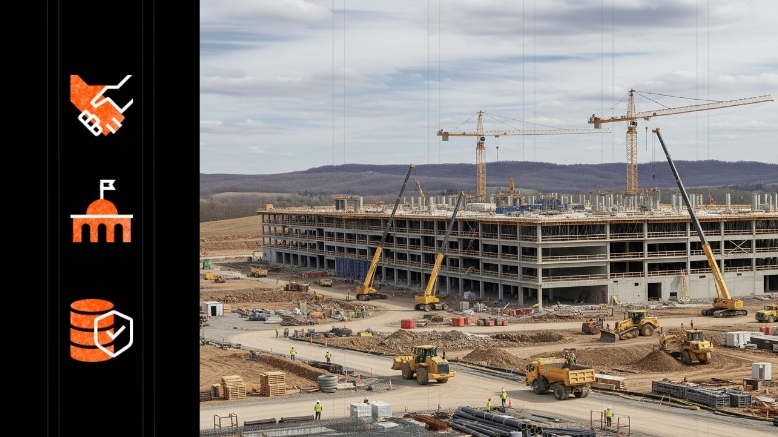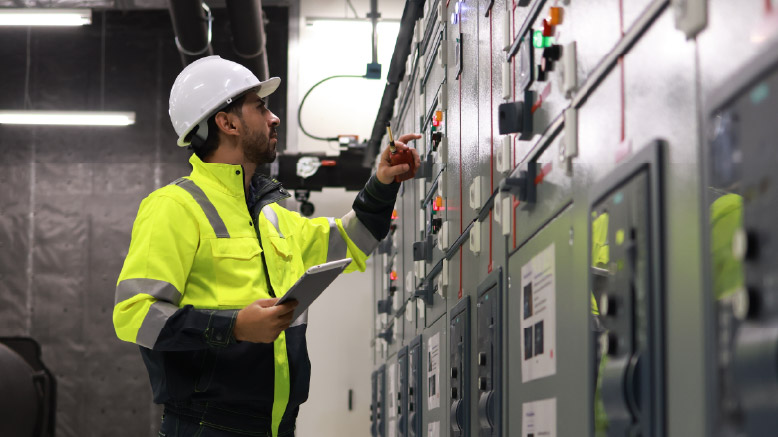— 5 min read
The New Frontier: How Data Centers Are Pushing the Limits of Construction


Last Updated Sep 23, 2025

Scott Bornman
Principal, Operational Excellence
15 articles
Scott Bornman is a managing strategic product consultant at Procore Technologies. Scott began his long construction career after a successful 8+ years in the U.S. Army, where he selected to be U.S. Army Recruiter following Desert Shield/Desert Storm. Scott has had many roles in the construction field since then, working his way from a project superintendent, to an owner's rep, to a senior project manager and even Vice President of Construction at Bognet Construction and Director of Construction at Plaza Construction before joining the team at Procore.

Marlissa Collier
33 articles
Marlissa Collier is a journalist whose work focuses on the intersections of business, technology, policy and culture. Her work has been featured in digital and print formats with publications such as the Dallas Weekly, XO Necole, NBCU Comcast, the Dallas Nomad, CNBC, Word in Black and Dallas Free Press. Marlissa holds an undergraduate degree in Construction Engineering from California State University, Long Beach and an MBA from Southern Methodist University’s Cox School of Business.
Last Updated Sep 23, 2025

The digital world never sleeps — and as such, neither can the infrastructure powering it. As demand for cloud services, artificial intelligence and streaming data continues to surge, data centers have become the new giants of modern construction.
Still, though some subject matter experts have become accustomed to wittily referring to data centers as “glorified server rooms”, these massive structures aren't the server rooms of the early 2000s.
Today’s data centers are massive, complex and fast-moving projects that stretch conventional construction methods to their breaking point.
Table of contents
A Race Against Time
Microsoft, now considered a leading AI company, recently completed a facility housing over 100,000 computers, with plans underway to scale up to one million according to CEO Steve Ballmer. These mega-centers require enormous footprints, robust infrastructure and precision coordination across trades and suppliers— often on a condensed schedule.
What makes these builds even more daunting for the builders tasked with erecting these massive structures is the pressure to go fast. With market competition and evolving technology cycles, project timelines are tightening. Contractors are expected to mobilize rapidly, sometimes breaking ground before designs are fully baked. This results in frequent change orders, coordination chaos and a constant balancing act between speed and quality.
When it comes to data centers, only schedule and quality truly matter. We prioritize uptime; the cost or number of people involved is secondary.

Scott Bornman
Principal, Operational Excellence
Procore Technologies
Adding to the challenge is the location of many of data center projects — often remote sites with limited workforce availability, strained infrastructure or permitting hurdles.
In these contexts, builders must think outside the box. Design-build models, modular construction and prefabricated components are gaining traction as ways to compress schedules and improve quality. In some cases, contractors are even co-locating workers onsite in temporary housing to minimize commute times and maximize productivity.
The industry is also seeing an increase in strategic joint ventures between construction firms and tech companies to pool expertise and streamline execution. With data center needs becoming more specialized, collaboration is now a critical differentiator.
Power-Hungry Giants
Power is the lifeblood of a data center — and in many places, it’s in short supply. Facilities now demand hundreds of megawatts, straining the limits of local utility grids. In response, developers are exploring hybrid solutions: solar farms, battery energy storage systems (BESS), diesel generators and even revisiting nuclear power as an option. Some, including US microreactor developer Last Energy, are considering repurposing decommissioned plants or investing in micro-reactors to create closed-loop systems that operate independently from local grids.
I used to think a simple utility tie-in and a backup generator were enough. Now, we're discussing building entire nuclear plants just to power these facilities.
Scott Bornman
Principal, Operational Excellence
Procore Technologies
Beyond the core energy needs, cooling adds another layer of complexity. Traditional HVAC systems are often insufficient to manage the heat load from high-density racks. To solve this, builders are adopting liquid cooling and immersion technologies, which not only require specialized infrastructure but also present new challenges for long-term maintenance and system integration.
In certain regions, developers are also exploring geographic advantages — such as placing facilities near large bodies of water or in naturally cooler climates — to minimize the energy burden associated with temperature regulation.
"We have real data with integrity to base our decisions on."
Learn how Vantage Data Centers created a single source of truth to improve data analytics, financial performance and communication across five continents.

Regulations, Resistance & Community Tensions
Despite the digital demand, local governments aren’t always welcoming of data center projects — especially when the perceived benefits don’t outweigh the burdens. Concerns range from energy consumption to noise, aesthetics, water usage and minimal job creation. In some cases, opposition has stalled or canceled major projects.
To stay ahead, developers are learning to be better neighbors. Some are investing in renewable power generation that can feed excess energy back to the grid, establishing community funds to support local services, or designing façades that blend with local architecture and reduce visual impact. Early stakeholder engagement and transparent communications are also becoming best practices.
Digital Tools for a Digital Problem
Managing projects of this size and complexity requires more than spreadsheets and email threads. Integrated construction software platforms that leverage Building Information Modeling (BIM), data analytics and AI are becoming increasingly important to delivering projects on time and on budget. These platforms help teams track materials, manage labor and even identify schedule risks — all in real time.
By analyzing historical and live project data, modern platforms can provide predictive insights into project performance and help allocate resources efficiently. The key is data hygiene: clean, standardized information entry is the foundation for any AI-driven tool.
AI's effectiveness is directly tied to the quality of its data. Good data hygiene is fundamental; without it, AI's insights are limited.
Scott Bornman
Principal, Operational Excellence
Procore Technologies
Some solutions now offer role-based dashboards tailored to the unique needs of CIOs, CFOs and project managers, helping different stakeholders stay aligned. Others integrate with sensor data and drone imagery to offer live feedback from the field, making it easier to adapt in real time.
The Future Becomes the Present
The rise of hyperscale data centers signals a new era for construction. These facilities demand unprecedented scale, speed — and specialization.
Innovation, adaptability and data-driven decision-making will be essential to keep up with demand. As the digital economy accelerates, builders who embrace advanced tools and new energy strategies — including nuclear options and modular construction — will lead the charge into this high-powered future.
BIM and construction software can play an important role in this transformation by enabling smarter planning, collaboration and risk management. In a world where milliseconds matter and uptime is gold, the future of construction will be defined not just by what gets built, but how intelligently it’s done.
Free AI in Construction Course with Hugh Seaton
Start learning today with industry expert Hugh Seaton and discover how AI can boost efficiency, reduce risk, and transform your projects.

Was this article helpful?
Thank you for your submission.
0%
0%
You voted that this article was . Was this a mistake? If so, change your vote
Scroll less, learn more about construction.
Subscribe to The Blueprint, Procore’s construction newsletter, to get content from industry experts delivered straight to your inbox.
By clicking this button, you agree to our Privacy Notice and Terms of Service.
Thank you!
You’re signed up to receive The Blueprint newsletter from Procore. You can unsubscribe at any time.
Categories:
Written by

Scott Bornman
Principal, Operational Excellence | Procore Technologies
15 articles
Scott Bornman is a managing strategic product consultant at Procore Technologies. Scott began his long construction career after a successful 8+ years in the U.S. Army, where he selected to be U.S. Army Recruiter following Desert Shield/Desert Storm. Scott has had many roles in the construction field since then, working his way from a project superintendent, to an owner's rep, to a senior project manager and even Vice President of Construction at Bognet Construction and Director of Construction at Plaza Construction before joining the team at Procore.
View profile
Marlissa Collier
33 articles
Marlissa Collier is a journalist whose work focuses on the intersections of business, technology, policy and culture. Her work has been featured in digital and print formats with publications such as the Dallas Weekly, XO Necole, NBCU Comcast, the Dallas Nomad, CNBC, Word in Black and Dallas Free Press. Marlissa holds an undergraduate degree in Construction Engineering from California State University, Long Beach and an MBA from Southern Methodist University’s Cox School of Business.
View profileExplore more helpful resources

Building Intelligence: How AI & Data Are Rewiring Construction for the Digital Age
As data center construction surges to meet the demands of AI, cloud computing, weekend streaming binges and real-time digital services, the pressure being put on builders by owners has reached...

Power, Politics & Permits: The External Forces Shaping Data Center Development
As the need for digital infrastructure accelerates, data centers have become essential to powering the world’s digital economy. Yet, behind every hyperscale facility is a complex web of external forces...

The Top 5 MEP Challenges of Data Centers
Data centers are unique builds that come with unique challenges. MEP contractors stepping up to build data centers are sure to encounter the complexity of systems and the demands of scalability,...

How Modular Construction Can Help Overcome Data Center Labor Shortages
Data center construction is booming — but as the sector grows, the demand for skilled workers to build these highly specialized projects increases. Labor shortages have emerged as a key...
Free Tools
Calculators
Use our calculators to estimate the cost of construction materials for your next project.
Templates
Find a template to help you with your construction project tasks.
Material Price Tracker
Get the latest U.S. retail prices and view historical trends for common building materials.
Glossary
Explore key terms and phrases used in the industry.
